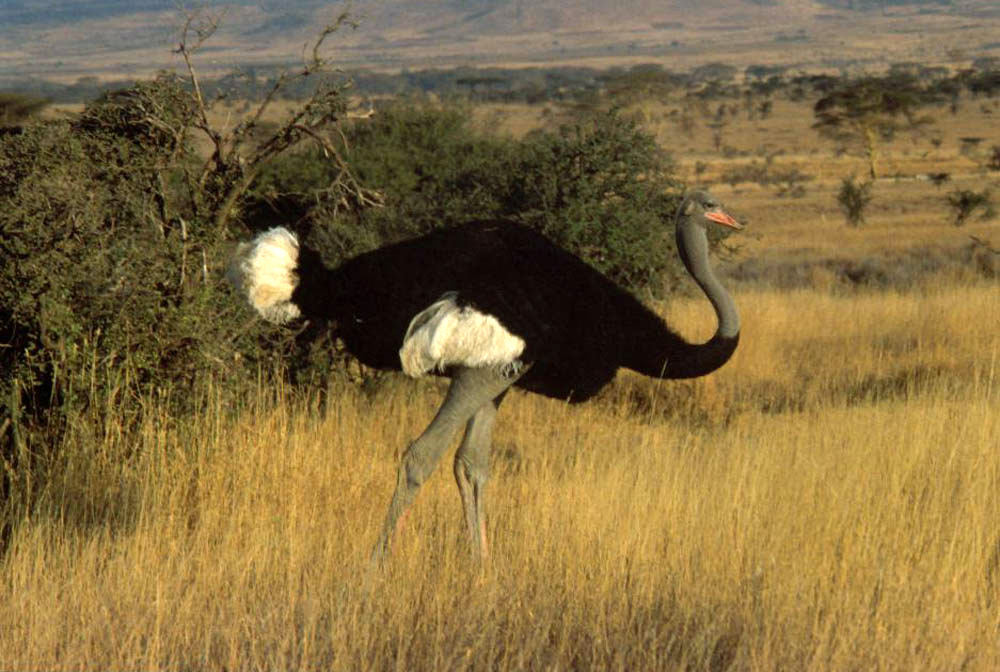|
Ostriches
Ostriches are large flightless birds. Two living species are recognised, the common ostrich, native to large parts of sub-Saharan Africa, and the Somali ostrich, native to the Horn of Africa. They are the heaviest and largest living birds, with adult common ostriches weighing anywhere between 63.5 and 145 kilograms and laying the largest eggs of any living land animal.Del Hoyo, Josep, et al. Handbook of the birds of the world. Vol. 1. No. 8. Barcelona: Lynx edicions, 1992. With the ability to run at 70 km/h (43.5 mph), they are the fastest birds on land. They are farmed worldwide, with significant industries in the Philippines and in Namibia. South Africa produces about 70% of global ostrich products, with the industry largely centered around the town of Oudtshoorn. Ostrich leather is a lucrative commodity, and the large feathers are used as plumes for the decoration of ceremonial headgear. Ostrich eggs and meat have been used by humans for millennia. Ostrich ... [...More Info...] [...Related Items...] OR: [Wikipedia] [Google] [Baidu] |
Common Ostrich
The common ostrich (''Struthio camelus''), or simply ostrich, is a species of flightless bird native to certain areas of Africa. It is one of two extant species of ostriches, the only living members of the genus ''Struthio'' in the ratite group of birds. The other is the Somali ostrich (''Struthio molybdophanes''), which has been recognized as a distinct species by BirdLife International since 2014, having been previously considered a distinctive subspecies of ostrich. The common ostrich belongs to the order (biology), order Struthioniformes. Struthioniformes previously contained all the ratites, such as the Kiwi (bird), kiwis, emus, Rhea (bird), rheas, and Cassowary, cassowaries. However, recent genetic analysis has found that the group is not monophyletic, as it is paraphyletic with respect to the tinamous, so the ostriches are now classified as the only members of the order. Phylogenetic studies have shown that it is the sister group to all other members of Palaeognathae, and ... [...More Info...] [...Related Items...] OR: [Wikipedia] [Google] [Baidu] |
Struthio Barbarus
Ostriches are large flightless birds. Two living species are recognised, the common ostrich, native to large parts of sub-Saharan Africa, and the Somali ostrich, native to the Horn of Africa. They are the heaviest and largest living birds, with adult common ostriches weighing anywhere between 63.5 and 145 kilograms and laying the largest eggs of any living land animal.Del Hoyo, Josep, et al. Handbook of the birds of the world. Vol. 1. No. 8. Barcelona: Lynx edicions, 1992. With the ability to run at 70 km/h (43.5 mph), they are the fastest birds on land. They are farmed worldwide, with significant industries in the Philippines and in Namibia. South Africa produces about 70% of global ostrich products, with the industry largely centered around the town of Oudtshoorn. Ostrich leather is a lucrative commodity, and the large feathers are used as plumes for the decoration of ceremonial headgear. Ostrich eggs and meat have been used by humans for millennia. Ostrich oil ... [...More Info...] [...Related Items...] OR: [Wikipedia] [Google] [Baidu] |
Struthio Brachydactylus
Ostriches are large flightless birds. Two living species are recognised, the common ostrich, native to large parts of sub-Saharan Africa, and the Somali ostrich, native to the Horn of Africa. They are the heaviest and largest living birds, with adult common ostriches weighing anywhere between 63.5 and 145 kilograms and laying the largest eggs of any living land animal.Del Hoyo, Josep, et al. Handbook of the birds of the world. Vol. 1. No. 8. Barcelona: Lynx edicions, 1992. With the ability to run at 70 km/h (43.5 mph), they are the fastest birds on land. They are farmed worldwide, with significant industries in the Philippines and in Namibia. South Africa produces about 70% of global ostrich products, with the industry largely centered around the town of Oudtshoorn. Ostrich leather is a lucrative commodity, and the large feathers are used as plumes for the decoration of ceremonial headgear. Ostrich eggs and meat have been used by humans for millennia. Ostrich ... [...More Info...] [...Related Items...] OR: [Wikipedia] [Google] [Baidu] |
Struthio Oldawayi
Ostriches are large flightless birds. Two living species are recognised, the common ostrich, native to large parts of sub-Saharan Africa, and the Somali ostrich, native to the Horn of Africa. They are the heaviest and largest living birds, with adult common ostriches weighing anywhere between 63.5 and 145 kilograms and laying the largest eggs of any living land animal.Del Hoyo, Josep, et al. Handbook of the birds of the world. Vol. 1. No. 8. Barcelona: Lynx edicions, 1992. With the ability to run at 70 km/h (43.5 mph), they are the fastest birds on land. They are farmed worldwide, with significant industries in the Philippines and in Namibia. South Africa produces about 70% of global ostrich products, with the industry largely centered around the town of Oudtshoorn. Ostrich leather is a lucrative commodity, and the large feathers are used as plumes for the decoration of ceremonial headgear. Ostrich eggs and meat have been used by humans for millennia. Ostrich oil ... [...More Info...] [...Related Items...] OR: [Wikipedia] [Google] [Baidu] |
Ostrich Leather
Bag «Classic» Braun. Ostrich leather is the result of tanning skins taken from African ostriches farmed for their feathers, skin and meat. The leather is distinctive for its pattern of vacant quill follicles, forming bumps ranged across a smooth field in varying densities. It requires an intricate, specialised, and expensive production process making its aesthetic value costly. Although the first commercial farming began in South Africa in 1850, the industry collapsed after World War I and the drop in demand for the feathers for fashionable hats and military uniforms. Other products were marketed, with each success battered by world events and droughts until now, when ostrich skin is globally available and seen as a luxury item in high-end demand. Ostrich leather began to be produced after ostrich farming was well established but after a tannery was set up onsite, it went on to make an impact in European haute couture and in the US for cowboy boots becoming widespread during ... [...More Info...] [...Related Items...] OR: [Wikipedia] [Google] [Baidu] |
Ostrich Egg
The egg of the ostrich (genus ''Struthio'') is the largest of any living bird (being exceeded in size by those of the extinct elephant bird genus '' Aepyornis''). The shell has a long history of use by humans as a container and for decorative artwork, including beads. The eggs are not commonly eaten. Biology The female common ostrich lays her fertilized eggs in a single communal nest, a simple pit, deep and wide, scraped in the ground by the male. The dominant female lays her eggs first, and when it is time to cover them for incubation she discards extra eggs from the weaker females, leaving about 20 in most cases. A female common ostrich can distinguish her own eggs from the others in a communal nest. Ostrich eggs are the largest of all eggs, though they are actually the smallest eggs relative to the size of the adult bird — on average they are long, wide, and weigh , over 20 times the weight of a chicken's egg and only 1 to 4% the size of the female. They are glossy c ... [...More Info...] [...Related Items...] OR: [Wikipedia] [Google] [Baidu] |
Ostrich Farming In Namibia
Around 1900, ostrich farming peaked in Southern Africa. The birds were farmed for their feathers and hides. Today that has changed for people have realised that ostrich meat is lean and healthy to eat. In Namibia, farmers catch the wild birds under license or buy eggs or young birds. Ostriches are becoming more and valuable because each and every part can be used. It is however expensive to rear ostriches on a large scale. Ostriches are wild birds that occur naturally in Africa. There are well adapted to the dry conditions of Namibia and can go for long periods without water. Domesticated ostriches are normally smaller than the wild ones. Reproduction in ostriches Ostriches are ready to breed when they are two to three years. Females always mature faster than males. The breeding season lasts from winter to mid summer. During this period both male and females display mating dances and behaviours. The females bore and ruffle their wings and the males do complicated dances and mak ... [...More Info...] [...Related Items...] OR: [Wikipedia] [Google] [Baidu] |
Struthio Asiaticus
The Asian or Asiatic ostrich (''Struthio asiaticus''), is an extinct species of ostrich that lived during the Neogene period on the Indian subcontinent. Discovery The early records that ranged from the Pliocene Epoch in Africa to the Pleistocene-Holocene Epoch in northeastern Asia are considered dubious.Buffetaut, E. Feduccia (2022) Beads made from shells taken from archaeological sites in India dating to more than 25,000 years were found to have traces of DNA and analysis of sequences examined from them show that the species is definitely in the genus ''Struthio''. Description Asian ostriches were large, being more robustly built and reaching about the same height as an adult male of the extant common ostrich. It may have had short toes, but this is considered a tentative assumption. A specimen from the Pliocene of Morocco could be 20% bigger than an adult male of the extant ''Struthio camelus The common ostrich (''Struthio camelus''), or simply ostrich, is a species o ... [...More Info...] [...Related Items...] OR: [Wikipedia] [Google] [Baidu] |
Ostrich Meat
Ostrich meat is a type of red meat obtained from the ostrich, a large flightless bird native to Africa. Known for its health benefits and sustainability, ostrich meat has gained popularity worldwide, particularly in health-conscious and gourmet markets. It tends to be darker than beef due to the high levels of final pH. History The consumption of ostrich meat dates back to ancient times, particularly in Africa where ostriches are native. The meat was traditionally hunted and consumed by various indigenous cultures. In the late 19th and early 20th centuries, ostrich farming began to spread to other parts of the world, including North America, Europe, and Australia, primarily driven by the demand for ostrich feathers. Today, ostrich meat is farmed commercially in various parts of the world, including the United States, South Africa, and Australia. Consumers can purchase ostrich meat in the United States from a few of the current ostrich farms including Amaroo Hills, American Ostr ... [...More Info...] [...Related Items...] OR: [Wikipedia] [Google] [Baidu] |




